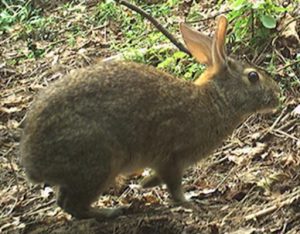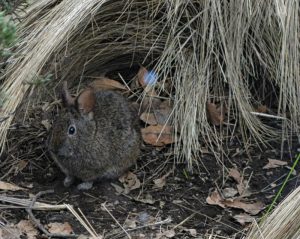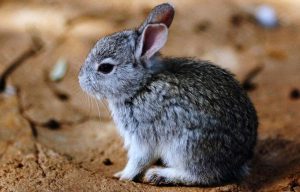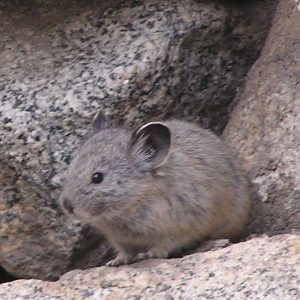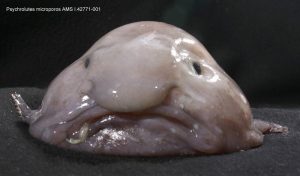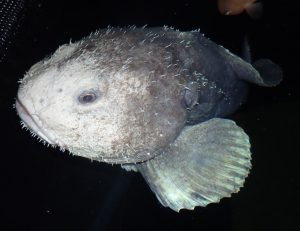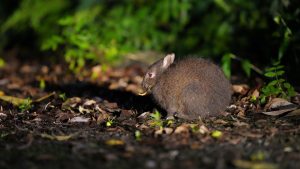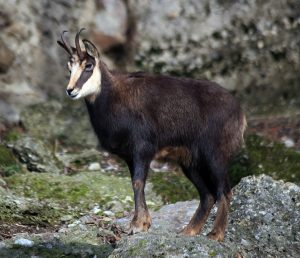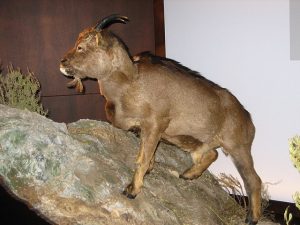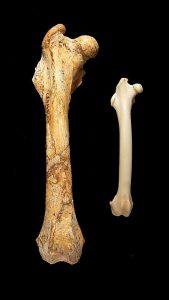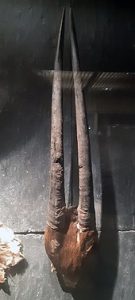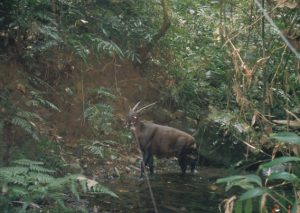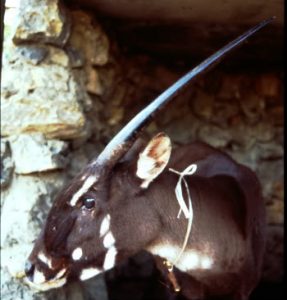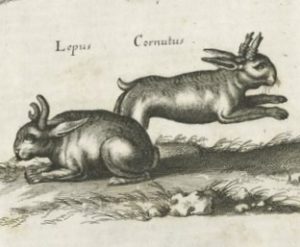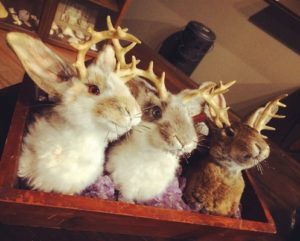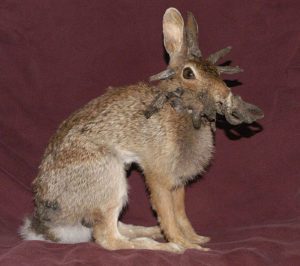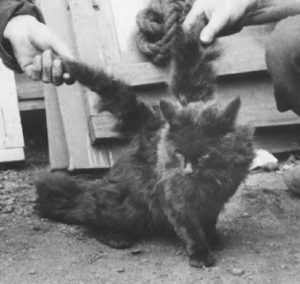Podcast: Play in new window | Download (Duration: 22:57 — 23.4MB)
Subscribe: | More
This week let’s learn about some giant-sized rabbits and hares! Also some regular-sized ones.
Further listening:
Life, Death & Taxonomy podcast episode about the Collared Pika
Further reading:
Dr Karl Shuker’s post about giant rabbits and hares
The National Cryptid Society’s post about giant rabbits and hares
An eastern cottontail rabbit:
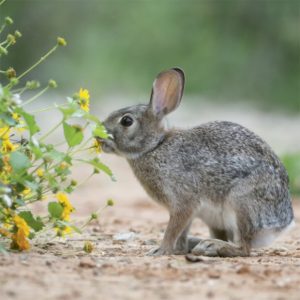
The Flemish giant looks Photoshopped. It’s a big bunny:
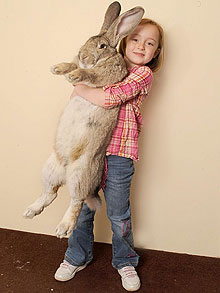
A European hare (also called the brown hare):
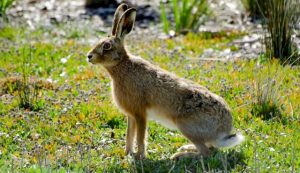
The Belgian hare is a domestic rabbit bred to look like a hare:
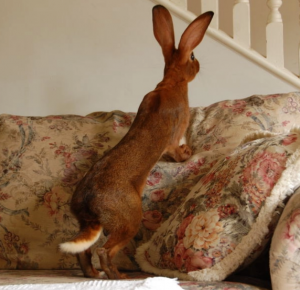
Show transcript:
Welcome to Strange Animals Podcast. I’m your host, Kate Shaw.
A few weeks ago we had an episode about some animal hoaxes that were based on true animal facts, including the horned hare. While I was researching that topic, I kept running across interesting facts about rabbits and hares, specifically mysterious reports about giant rabbits. So this week, let’s have a whole episode about gigantic rabbits and hares.
We’ll start with some general information. Collectively rabbits and hares are called leporids after their family, Leporidae, or lagomorphs after their order, Lagomorpha. Lagomorphs include pikas, which are really cute and look sort of like oversized hamsters. The podcasts Species and Life, Death and Taxonomy both did really good episodes about the pika recently, so we’re just going to talk about rabbits and hares today.
Leporids are famous for hopping instead of walking, and they’re able to do so because their hind legs are longer than their front legs and have specialized ankle joints. Ancestors of leporids developed this ankle as much as 53 million years ago, but their legs were much shorter so they probably ran instead of hopped. Hares have longer legs than rabbits and can run faster as a result, but both rabbits and hares are known for their ability to bound at high speeds. When a rabbit or hare runs, it pushes off from the ground with the tips of its long hind toes, and its toes are connected with webbed skin so they can’t spread apart. If the toes did spread apart, they would be more likely to get injured. Rabbits and hares also don’t have paw pads like dogs and cats do. The bottom of a leporid’s foot is covered with dense, coarse fur that protects the toes from injury. Its long claws help it get a good purchase on the ground so its feet won’t slip.
Baby rabbits are called bunnies, kits, or kittens, and like baby dogs and cats, they’re born helpless, without fur and with their eyes still sealed closed. Baby hares are called leverets and are born fully developed, with fur and with their eyes open.
Leporids eat plants, including grass, weeds, twigs, and bark. Animals that eat grass and other tough plants have specialized digestive systems so they can extract as many nutrients from the plants as possible. Many animals swallow the plants, digest them for a while, then bring up cuds of plants and water to chew more thoroughly. Rabbits and hares don’t chew their cud in that way, but they do have a system that allows them to digest the plants they eat twice.
After a leporid eats some plants, the plants go into the stomach, naturally, and then travel into the first part of the large intestine, called the cecum. The cecum separates the softer parts of the plants from the harder, less digestible parts. The hard parts are compressed into hard pellets that the rabbit poops out. But the soft parts of the plants, which are most nutritious, develop into softer pellets. These are called cecotropes, and as soon as the rabbit poops out the cecotropes, it immediately eats them again. This allows the digestive system to get a second round to extract more nutrients from the plants.
Most rabbit species are native to North America, but there are also rabbits native to parts of South America, parts of Europe and Asia, parts of Africa, and a few Japanese islands. They’ve also been introduced to other areas of the world, especially Australia, where they’re a real pest since rabbits eat a lot and reproduce rapidly.
Most hare species are native to Eurasia, with some species also living in parts of Africa, North America, and some Japanese islands. Despite its name, the jackrabbit of North America is a hare.
Hares live above ground and are generally solitary. Almost all rabbits are sociable and sleep underground in warrens and burrows. The exceptions are the rare hispid hare of South Asia, which is actually a rabbit, and the cottontail rabbit of North America. These rabbits make nests in long grass like hares do to raise their babies. Eastern cottontails are the rabbits I’m familiar with, and the cottontail gets its name because its short tail is white all over instead of only white underneath. It looks like a powder puff.
Hares aren’t domesticated, but rabbits have been and there are a lot of breeds of domestic rabbit. I had a pet red satin when I was a kid. Her name was June and she was beautiful. Domestic rabbits can be trained to use a litter box just like a cat, but unlike most cats, rabbits will chew on everything. I say most cats because I had a cat once who liked to chew through phone cords, back when I had a landline phone. But a rabbit will chew on all cords, on furniture, on wallpaper, and things like that if the rabbit isn’t trained and isn’t given appropriate things to chew on. A pet rabbit can be spayed or neutered just like a pet dog or cat to make it healthier, less likely to spray urine to mark its territory, and less aggressive.
So now we have a good idea of what rabbits and hares are like. Now let’s find out about some gigantic and mysterious leporids.
I’ll start with an account by a witness named Evelyn who saw something unusual while waiting for the school bus one morning. This happened in New Jersey, which is in the northeastern United States. I’ll quote the account I found in the National Cryptid Society archives.
“In 1954, I had just turned 14. I was waiting for the school bus at 6:45 AM by our house in the country, which was across the road from a holly farm. At that time before they planted hollies it was mostly weeds along the road but sweet potatoes in the rest of the field.
“I glanced over at the 10+ acre field in front of me and there sat what appeared to be a huge ‘rabbit.’ It was brown and I was roughly ten to fifteen feet from it. I had seen hares before but this was not a hare; besides, hares hadn’t been seen in that part of New Jersey in forty years.
“This creature was sitting on its haunches and stood nearly four and a half feet tall. It just watched me for several minutes, and then it just disappeared! It did not hop away.
“I wasn’t frightened. I had a strange feeling of peace. I had such a calm, peaceful feeling. It was almost as if it was reassuring me it was not unreal; that is the only way I can explain it.
“No one else ever saw it and my family lived there for over 25 years. To this day I wonder what it really was and where it came from.”
Wow, wait, what?? How does an animal that big just disappear? Like, actually vanish into thin air?
Let’s take a closer look at the details here and see what we can figure out.
We’ll start with the detail about the sweet potatoes in hopes of figuring out what time of year it was. In New Jersey, sweet potatoes are planted around the end of spring and harvested in late summer into early autumn. In other words, if there were sweet potatoes in the field, the days would be long and it would have been fully light at 6:45 am. So Evelyn probably did get a good look at the animal for at least a minute.
She also states she was only ten to fifteen feet away from it, which would be about 3 to 4 and a half meters away. That’s really close. But from the way she describes the scene, it sounds like she was across the road from the field where she saw the animal. She says she was waiting by her house, which was across from the farm. I actually measured the road in front of my house when I was researching episode 17 about the Thunderbird. My road is a typical two-lane road in a small town and I believe it measured 18 ½ feet, or just over 5.6 meters. Of course, I don’t know how wide roads were back in 1953, but it’s likely Evelyn was a little farther away from the animal than she remembers.
It sounds like the animal was close to the road, probably in the weeds along the edge of the road rather than in the cultivated field full of sweet potatoes. Deer are considered sweet potato pests but rabbits aren’t, so if it was a giant rabbit of some kind, it was probably eating weeds instead of sweet potato leaves.
Next, what kind of rabbits and hares live in New Jersey? The eastern cottontail and the New England cottontail are both small rabbits that Evelyn would have recognized easily. The European hare, black-tailed jackrabbit, and white-tailed jackrabbit, which are all hares, have been introduced into parts of New Jersey for hunting at different times. But Evelyn states specifically that this was not a hare.
The snowshoe hare is sometimes seen in northern New Jersey and might occasionally stray farther south. I don’t know what part of New Jersey Evelyn was from, but sweet potato farming is more common in the southern parts of the state. The snowshoe hare is more rabbit-like in appearance than other hares, since its ears are smaller and its body more rounded. Its fur usually turns white in winter to camouflage it against the snow, but in summer it would be brown. And it’s also fairly large, certainly bigger than a cottontail rabbit. Not counting the tail, a snowshoe hare can grow up to a foot and a half long, or 48 cm. If it was sitting up on its hind legs, especially if it was sitting up high on its hind legs to watch Evelyn in case it needed to run, it might appear to be even bigger, say two feet or more, or over 61 cm. But even accounting for the animal’s size being exaggerated in Evelyn’s memory, that’s still a lot smaller than the almost four and a half foot tall animal she describes. Four and a half feet is 137 cm. That’s really tall.
If you’ve listened to episode 73, about phantom kangaroos, you know that wallabies and kangaroos are sometimes kept as pets in the United States and often escape. Wallabies and kangaroos have long ears, long hind legs, and sit up like rabbits and hares. If Evelyn saw a wallaby but didn’t see its long tail, she might have thought she was looking at an enormous rabbit.
But…it disappeared. Hares are considered masters of hiding and are said to be able to seem to disappear from view even in short grass, but how in the heck can an animal more than four feet tall just vanish?
I don’t have an answer, so all I can offer is that either Evelyn misjudged the animal’s size and thought it was much larger than it was, and it was able to drop down quickly and appear to vanish in tall weeds, or Evelyn actually saw a ghostly giant rabbit of some kind that actually vanished. Now this sounds like a Halloween episode. At least her ghost rabbit wasn’t scary. She even points out that she felt peaceful after seeing it.
Evelyn isn’t the only person who’s reported seeing a giant rabbit or hare. In 1976 in Dorset, England, a woman named Louise Hodgson and two men out walking their dogs in the evening saw a group of about a dozen hares in a field. This was in September so it was unusual to find that many hares together just to start with, since hares are usually solitary except during mating season in spring. But there was a bigger animal with the hares. The dog-walkers at first thought it was a roe deer due to its size, but then they realized it was another hare, but huge. A roe deer stands no more than two and a half feet at the shoulder, or 75 cm, which is the same measurement of the length of a large European hare’s body. So a European hare could appear as tall as a roe deer when sitting up, but then why did it appear so much larger than the other hares?
In April of 2006, not long after the awesome movie Wallace & Gromit and the Curse of the Were-Rabbit was released, reports of a giant rabbit eating up gardens in Northumberland, England hit the news. People thought it was an April Fool’s joke, but the gardeners were furious and had proof: giant-sized rabbit footprints, and of course their destroyed produce. They reported that the rabbit was the size of a dog and was black and brown in color. The first witness saw it in February of that year. But before anyone could get a good photo of the rabbit or capture it, a local woman reported that she’d been driving one night in early April when a massive rabbit bounded in front of her car. She wasn’t able to stop and collided with the rabbit, which was so big that the front bumper of her car was damaged. The rabbit died, unfortunately, and the woman said she got out and looked at it. She estimated it was at least two feet long, or 61 cm, with long legs. Rabbit fur was found stuck in the damaged bumper of her car, but the dead rabbit was long gone, probably eaten by a fox. After that the giant rabbit wasn’t seen again and the gardeners were left in peace.
And in 2017 a man reported that when he was a kid in the late 1960s, in Placer County, California, he and his mother both saw some jackrabbits that were almost four feet tall when they sat up, or 1.2 meters. The best part of this story is that they saw more than one giant jackrabbit.
So what could these giant hares and rabbits be? Do leporids ever really get that big?
Actually, yes. There are two breeds of domestic rabbit that are enormous. One is called the Flemish giant and the other is a British breed called the Continental giant. Both were originally bred for fur and meat, but are good-natured rabbits that are often kept as pets these days. A typical domestic rabbit is roughly the size and weight of a small to medium-sized cat, but a Flemish or continental giant rabbit can be as large as a medium-sized dog. The biggest is a rabbit named Darius, who is officially four feet four inches long, or 134 cm. Pictures of him and other domestic breed giants look photoshopped, because how can a rabbit be so big? But they are.
It’s probable that the Northumberland giant rabbit was a Flemish or continental giant that had escaped its home. But what about the giant hares reported in other places? Hares look much more slender and angular than rabbits and usually have longer ears.
Some cryptozoologists suggest that an extinct leporid might be the culprit, if it isn’t really extinct. Nuralagus rex, also called the Minorcan giant lagomorph, and sometimes referred to as a giant jackrabbit, was only described in 2011 and went extinct 3 to 5 million years ago. But Nuralagus wasn’t a jackrabbit and it only lived on one island, Menorca in the Mediterranean Sea. While it was related to modern rabbits and hares, it was definitely very different and not really all that big. It probably stood about a foot and a half high at the highest part of the back, or around half a meter, and was big and heavy. But it had small eyes and ears, and it probably couldn’t hop or even run very fast. If it was alive today, no one would think it was even related to a rabbit or hare.
The king hares seen in parts of England might be unusually large hares whose size has been exaggerated, since it’s hard to estimate size of an animal seen in the distance or seen only briefly. The king hare seen by Louise Hodgson in Dorset amid a bunch of smaller hares might actually have been a large hare in a field of rabbits, which Hodgson and her companions might have interpreted as being one giant hare and a lot of normal-sized hares. Hares and rabbits don’t typically interact where their ranges overlap, but they also don’t apparently dislike each other. A solitary hare might feed in a field where rabbits are also feeding.
Of course it’s also possible that there are anomalously large hares born sometimes. But there is another possibility.
In the mid-1980s, a man named Andrew Munro was walking through his mother’s garden in County Cork, Ireland when he saw a huge hare. He stopped and stared at it, and it stopped and stared at him, standing on its hind legs with its ears perked up. Munro estimated it was over four feet tall, or 1.2 meters. Munro’s dog saw it and gave chase, but the hare bounded away and was gone in moments.
This is an interesting sighting, because Munro pointed out that the hare was only four feet tall because it was standing up tall on its hind legs with its long ears up. A large hare can have ears more than half a foot long, or 15 cm. If you add the ear length to the body and head length, a big hare sitting up can measure three feet, or over 91 cm, and if it’s also standing on its hind legs instead of sitting on its bottom, that adds more height. So maybe we’re talking about big hares, but not ENORMOUS hares.
Not only that, there’s a breed of domestic rabbit called the Belgian hare that was bred to look like a hare. It’s slender, strong, and energetic, with long ears and legs. It was first bred in the early 18th century and was considered a meat rabbit, and while it’s not as heavy or bulky as a Flemish giant or continental giant rabbit, it’s big, much bigger than a wild hare. In fact, the Flemish giant was developed from the Belgian hare breed.
The Belgian hare became incredibly popular at the end of the 19th century and beginning of the 20th as a meat rabbit and as a show rabbit. Some prize Belgian hares sold for as much as a thousand dollars, which is expensive now and was ridiculously expensive back in the olden days. By 1917 its popularity had fallen, mostly because there were just so many Belgian hares that the price dropped to almost nothing, which made fewer people want to bother keeping them to sell.
According to zoologist Karl Shuker’s blog, during the 1940s, Belgian hares may have been released into the wild in Ireland with the expectation that people could shoot them for meat. But before long Ireland was overrun with rabbits to such an extent that they were eradicated. I can’t find anything else about this online so this might not be the case, or the rabbits might only have been released in one small area, but it is interesting to consider that the big hare Andrew Munro saw in the 1980s might actually have been a descendant of one of these hare-like rabbits.
We’ll finish with another interesting rabbit, but not a big one. It’s the marsh rabbit, and it’s a type of cottontail that lives in swamps and along the coast of the southeastern United States. It’s smaller than other cottontail species with small ears and shorter legs, and it always lives around water. There are three subspecies, including the endangered Lower Keys marsh rabbit that lives in the Florida Keys.
The marsh rabbit can hop just fine like other rabbits, but because its legs are so much shorter than other rabbit species, it can also walk. Its walking gait resembles a cat’s. This helps it navigate dense vegetation more easily. Not only that, its toes are much more widely spread than in other rabbit species.
But the really extraordinary thing about the marsh rabbit is that it likes to swim. It spends a lot of time in the water—and I mean, actually in the water. It mostly eats aquatic plants. It will submerge itself in muddy water to hide with just its nose and eyes above water and its ears laid flat to hide them. If a predator approaches, the rabbit will swim away. This is not behavior I think of when I think of rabbits but you have to admit, it’s adorable.
You can find Strange Animals Podcast online at strangeanimalspodcast.com. We’re on Twitter at strangebeasties and have a facebook page at facebook.com/strangeanimalspodcast. If you have questions, comments, or suggestions for future episodes, email us at strangeanimalspodcast@gmail.com. We also have a Patreon if you’d like to support us that way.
Thanks for listening!
